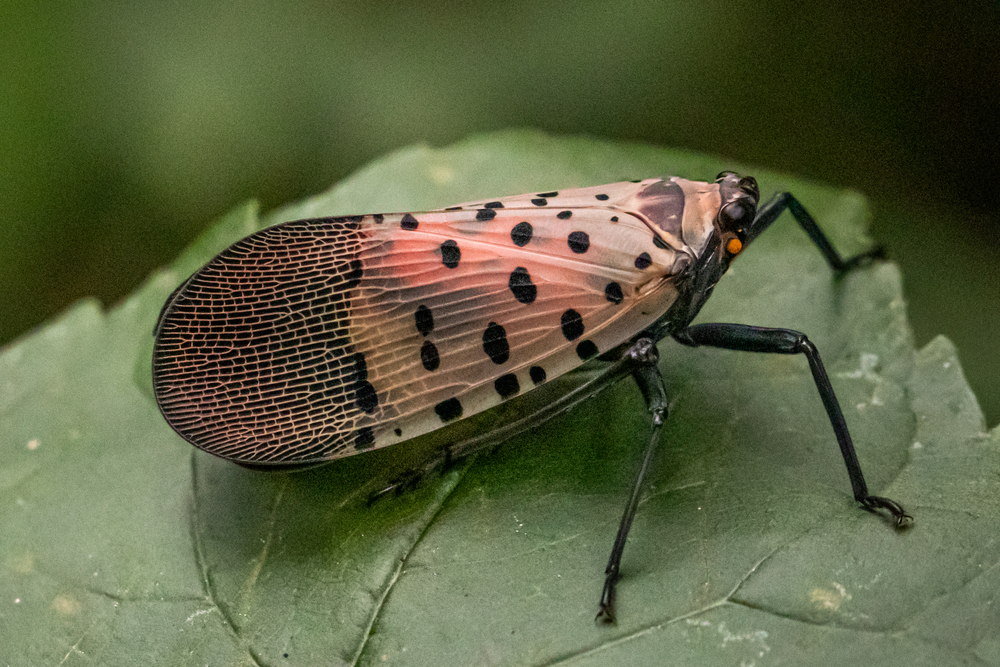NJ homeowners have been seeing more of the spotted lanternfly lately, and this is a prime example of an invasive insect species spreading into new areas. The immediate concern with new insects is the damage they create in the ecosystem, and the secondary concern is how our society can prevent or mitigate the spread of invasive insects.
The spotted lanternfly (Lycorma delicatula) is considered a significant agricultural pest. Since its discovery in Pennsylvania in 2014, it has raised concerns among farmers, researchers, and agricultural officials. Here are the critical areas of concern related to the plant damage caused by the spotted lanternfly:
- Feeding Damage: Spotted lanternflies feed on the sap of plants using their piercing-sucking mouthparts. This feeding can weaken the plant, reduce its vigor, and in some cases, lead to plant death, especially when there are large insect populations.
- Honeydew Excretion: As they feed on the sap, these insects excrete a large amount of a sugary waste product called honeydew. This sticky substance falls onto the leaves and branches below, and it can cover the surfaces of anything underneath the infested plants, including other plants, cars, patios, and more.
- Sooty Mold Growth: The honeydew excreted by the lanternflies provides an ideal medium for the growth of a black fungus called sooty mold. While this mold doesn't directly harm the plant, it can cover leaf surfaces, reducing photosynthesis and overall plant health. Additionally, it's unsightly and can reduce the aesthetic and economic value of ornamental plants and trees.
- Economic Impact: The spotted lanternfly poses a significant threat to several industries, including viticulture (grape growing), orchards, and logging. For example, they can cause considerable damage to grapevines, reducing the yield and quality of grapes, which is a significant concern for wine producers.
- Tree Damage: Trees, like the tree of heaven (Ailanthus altissima) and various hardwoods, can suffer from oozing wounds due to feeding. This oozing can attract other insects and further weaken the tree.
- Secondary Pests: The wounds caused by the lanternflies can be entry points for other pests or pathogens, leading to secondary infestations or infections.
Now that we have discussed the type of damage these insects create, let's review the crops and plants that are seeing the biggest impact.
Here's how the spotted lanternfly affects agriculture:
- Grapes: One of the most severely affected crops is grapevines. Spotted lanternflies prefer to feed on grapevines, and their feeding can lead to reduced yield and quality of grapes, impacting the viticulture industry, particularly wine production.
- Fruit Trees: The insect feeds on various fruit trees, including apple, cherry, and peach trees. Their feeding can reduce fruit yield and quality.
- Hardwood Trees: Spotted lanternflies also feed on a variety of hardwood trees, which can impact the timber industry. Trees like maple, oak, walnut, and poplar are among their targets.
- Tree of Heaven (Ailanthus altissima): While this tree is considered invasive in the U.S., it's a preferred host for the spotted lanternfly. However, the concern is that lanternflies can multiply rapidly on these trees and then spread to nearby crops.
How do invasive insect species spread to the United States?
Invasive insect species can arrive in the United States (or any other country) through multiple pathways. Here are some of the most common ways invasive insects find their way to new territories:
1. Trade and Shipping: This is a primary means of introduction. Insects can stow away in shipping containers, wooden packaging materials (like pallets or crates), or even on the goods themselves. For example, the Asian long-horned beetle is believed to have arrived in the U.S. in wooden packing material from China.
2. Plant Imports: Plants brought into the country for horticulture, agriculture, or as souvenirs can harbor invasive insects or their eggs/larvae. The European gypsy moth, for instance, was introduced into the U.S. when a French scientist brought them in the late 19th century, hoping to start a silkworm industry.
3. Accidental Transport: Insects can accidentally hitch a ride on vehicles, planes, boats, and even personal luggage. Once these transportation modes arrive at their destinations, the insects disembark and establish themselves in a new environment.
4. Natural Dispersal: Some invasive species can simply fly or be blown across borders by wind or storms, especially if they're coming from neighboring regions.
5. Illegal or Unintentional Release: Sometimes, insects kept as pets, study specimens, or for other purposes are released (either intentionally or by accident) into the environment where they can become invasive.
6. Agricultural Imports: Insects can arrive as pests on agricultural products, such as fruits, vegetables, and grains, which are imported for consumption.
7. Ballast Water: Ships take on ballast water in their port of origin and discharge it at their destination to maintain stability. This ballast water can contain a variety of organisms, including invasive insect species.
8. Migration: Some insect species naturally migrate long distances. If conditions in a new region are favorable, they might establish populations there.
To counteract these introductions, many countries, including the U.S., have quarantine and inspection protocols at ports of entry. The U.S. Department of Agriculture's Animal and Plant Health Inspection Service (APHIS) and the Customs and Border Protection (CBP) work to intercept and prevent the entry of invasive insect species. However, catching every potential invader is challenging, given the vast volume of goods and travelers entering the country.
How do we combat invasive insect species that are currently present?
Invasive insect species are combated using a variety of methods, depending on the specific insect, its life cycle, the environment it has invaded, the severity of the infestation, and available resources. Different strategies aim to eradicate, control, or manage the spread of the invasive species. Here are some of the primary methods employed:
- Physical/Mechanical Control:
- Hand Removal: Insects, their larvae, or their eggs are physically removed from the environment. This method is often labor-intensive and is usually feasible only for small-scale infestations.
- Traps: Different traps, such as pheromone traps, light traps, or sticky traps, can be used to capture and monitor insect populations.
- Biological Control:
- Predators: Introducing or encouraging natural predators of the invasive species can help reduce their populations. For instance, certain beetles have been released to control invasive aphid populations.
- Parasitoids: Some insects lay their eggs inside or on the invasive insect. Once the eggs hatch, the emerging larvae consume the host insect.
- Pathogens: Certain bacteria, fungi, or viruses can be used to infect and kill invasive insect populations.
- Chemical Control:
- Insecticides: These are chemicals specifically designed to kill insects. They can be sprayed on affected areas or used to treat specific plants or trees.
- Soil Treatments: For insects that have soil-dwelling stages, soil treatments can help control their populations.
- Cultural Control:
- Crop Rotation: Changing the crops grown in a particular field can disrupt the life cycle of insects that prefer specific plants.
- Sanitation: Removing infested plant material and debris can help reduce habitats for invasive insects.
- Resistant Varieties: Some plants are bred to be resistant to specific pests, reducing the impact of the invasive species.
- Regulatory and Quarantine Measures:
- Inspections: Regular checks at ports of entry, like airports and ship docks, can prevent the introduction of invasive species.
- Quarantines: Infested areas can be quarantined to prevent the movement of the invasive insect to new areas.
- Public Education: Educating the public about the risks associated with transporting plants or other potential carriers can help in prevention.
- Integrated Pest Management (IPM):
- This approach combines multiple methods based on the biology of the invasive insect, the ecology of the environment, and available control tools. It aims for effective, long-term pest control while minimizing negative impacts on the environment, humans, and non-target organisms.
Selecting the appropriate method or combination of methods requires thorough knowledge of the invasive insect's biology and behavior, as well as a consideration of environmental impacts, costs, and potential long-term effectiveness.
In summary the Spotted Lanternfly is just 1 invasive insect species but its a great example of the problems that can be caused by global commerce.
If you live in the Morris County area and need help around your home with these insects or other insects like the brown marmorated stink bug, then please give Permakill Exterminating a call.


